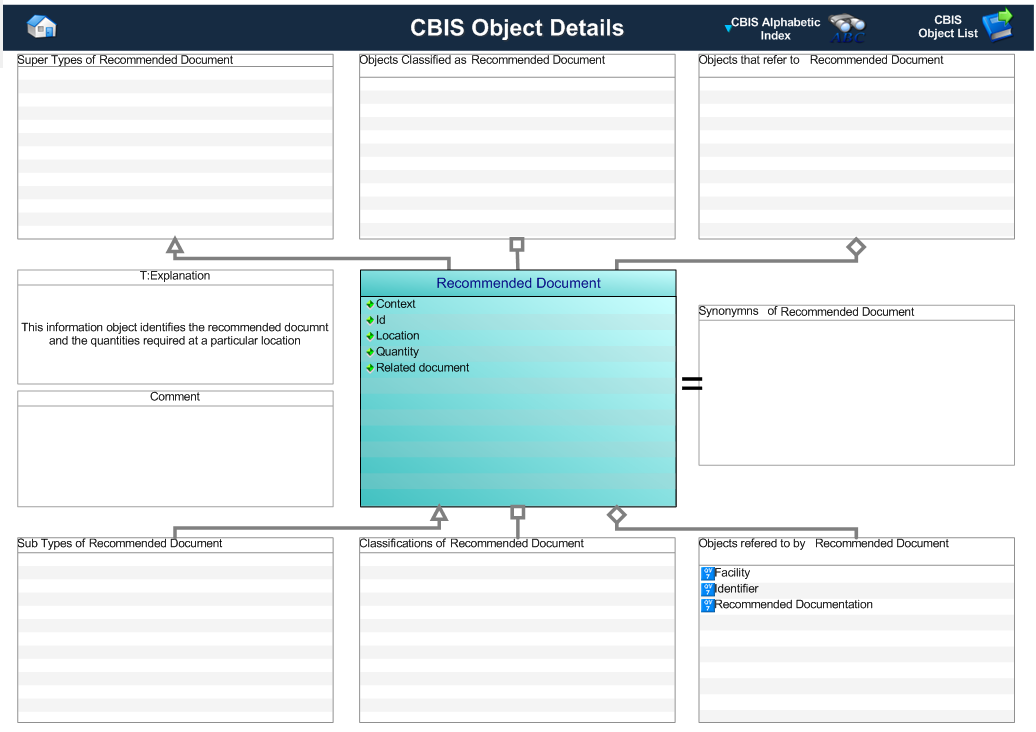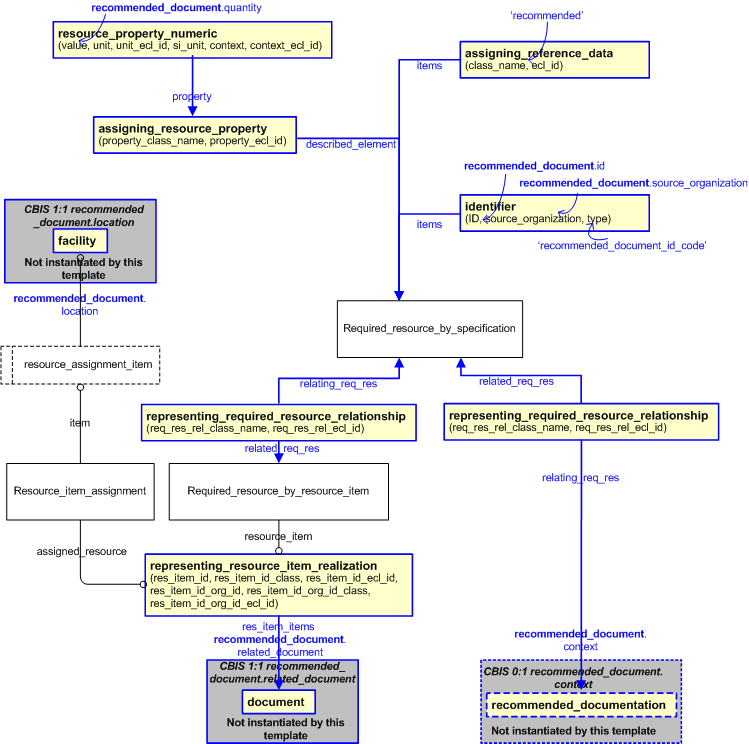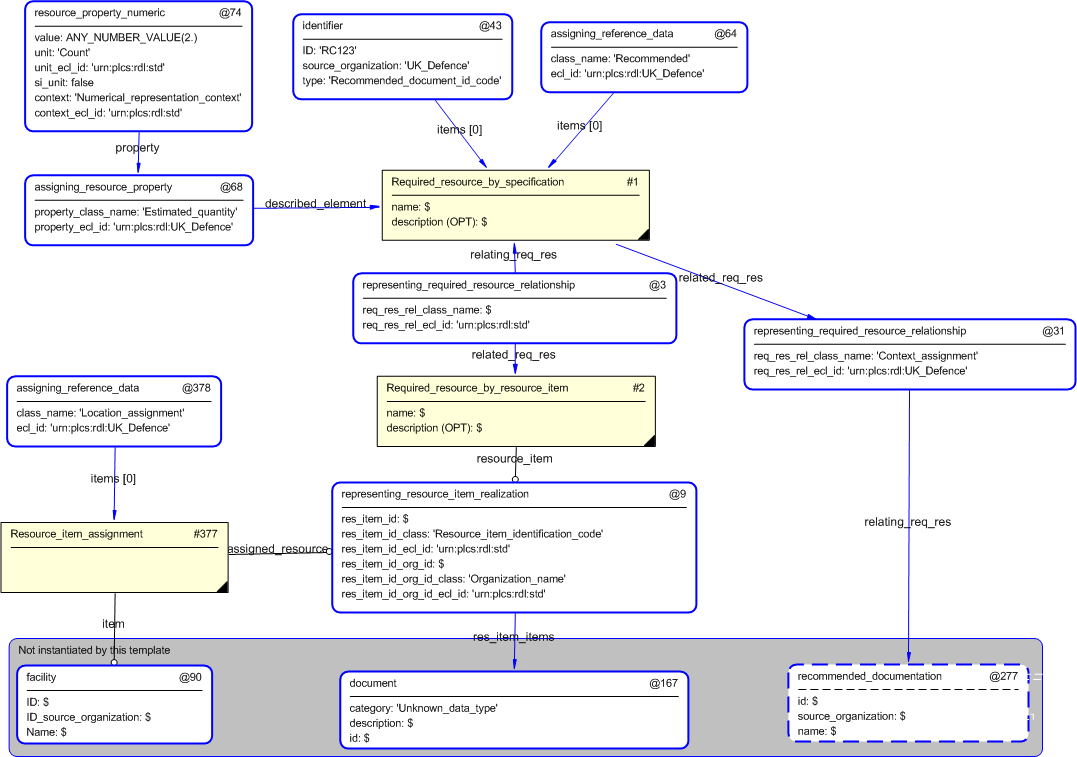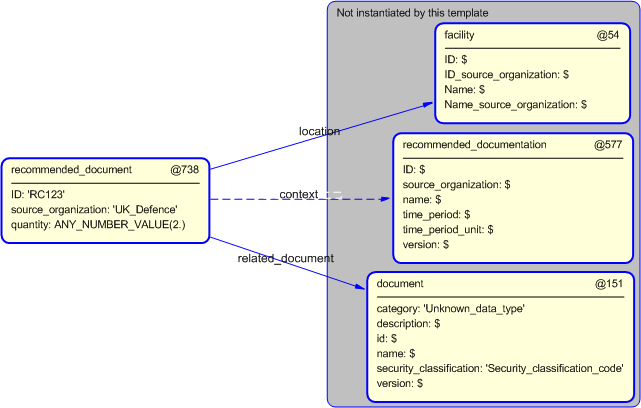Template:— recommended_document (rec_doc)
Context:— UK_Defence |
Date: 2009/04/17 11:15:01
Revision: 1.6
|
This section specifies the template recommended_document.
NOTE
The template has been defined in the context of
UK_Defence.
Refer to the business context for details of related templates.
NOTE
An explanation of a template and the associated instantiation path is
provided in the
Template overview
section.
This template describes how to represent the identification of the recommended document and the
quantities required at a particular location
The recommended document business object is used by those UK_Defence Data Exchange
Specifications that require information about the identification of the recommended document
and the quantities required at a particular location.
Figure 1 — Graphical Representation for Business Object Recommended Document
Recommended Document:
The definition of a Recommended Document object is:
Data about the identification of the recommended document
and the quantities required at a particular location.
|
Attribute name
|
Attribute description
|
Attribute type
|
Optionality
|
| Context |
This is a reference to the recommended documentation for which this document is part. |
Relationship to Recommended Documentation |
Optional |
| ID |
This is the identifier of the recommended document. |
Identifier |
Mandatory |
| Identifier.id |
This is the value of the id attribute of the Identifier applied to the recommended document. |
intrinsic |
Mandatory |
| Identifier.type |
This attribute is the type associated with the id of the Identifier given to the recommended document. |
Recommended_document_id_code |
Mandatory |
| Identifier.source_organization |
This attribute is the value representing the source organization that provides the id of the Identifier given to the recommended
document. This value is assumed to be a type of Organization_identification_code.
|
Organization_identification_code |
Mandatory |
| Location |
This is a reference to the location of the document. |
Relationship to Facility |
Mandatory |
| Quantity |
This is the quantity of the recommended document for a particular location. |
Intrinsic |
Mandatory |
| Related document |
This is the reference to the document. |
Relationship to Document |
Mandatory |
Table 1 — Recommended Document attribute details
The EXPRESS-G diagram in
Figure
2
shows the templates and EXPRESS entities that are required
to represent the template
"recommended_document".
The text highlighted in blue shows the template parameters.
Figure 2 — An EXPRESS-G representation of the Information model for recommended_document
The graphic for the template to be used in other EXPRESS-G diagrams
is shown in Figure
3
below.
Figure 3 — The graphical representation of the recommended_document template
The following input parameters are defined for this template:
This is a reference to the recommended documentation for which this document is part..
This is the identifier of the recommended document.
The organization that created the recommended document. Additionally
a Person or Information System could be defined when either of these are the source; see Identifier template.
This is a reference to the location of the document.
This is the quantity of the recommended document for a particular location.
This is the reference to the document.
The following reference parameters are defined for this template:
%^target = $recommended_document.doc_req_res_spec%
%^target = $recommended_document.doc_req_res_item%
Allow the
Resource_item
entity instantiated in this path to be referenced when this template is used.
Note: The
Resource_item
entity can be referenced in a template path by:
%^target = $recommended_document.doc_res_item%
where
target
is the parameter to which the
Resource_item
is bound.
%^target = $recommended_document.res_item_ass%
The instantiation path shown below specifies the entities that are to be
instantiated by the template.
A description of templates and the syntax for the instantiation path is
provided in the
Templates Help/Information section.
-- required resource Required_resource_by_specification%^doc_req_res_spec =
Required_resource_by_specification%
-- document resource item /
representing_resource_item_realization(
res_item_id='',
res_item_id_class='',
res_item_id_ecl_id='urn:plcs:rdl:std',
res_item_id_org_id='',
res_item_id_org_id_class='',
res_item_id_org_id_ecl_id='urn:plcs:rdl:std',
res_item_items=@related_document)/
%^doc_res_item = $representing_resource_item_realization.res_item%
-- required resource resource item Required_resource_by_resource_itemRequired_resource_by_resource_item.resource_item ->
^doc_res_item
%^doc_req_res_item =
Required_resource_by_resource_item%
-- relate required resources specification and resource item /
representing_required_resource_relationship(
req_res_rel_class_name='Required_resource_relationship',
req_res_rel_ecl_id='urn:plcs:rdl:std',
relating_req_res=^doc_req_res_spec,
related_req_res=^doc_req_res_item)/
-- assign a quantity to the required resource and classify it /
assigning_resource_property(
property_class_name='Estimated_quantity',
property_ecl_id='urn:plcs:rdl:uk_defence',
described_element=^doc_req_res_spec)/
%^property = $assigning_resource_property.property%
-- assign a value and unit to the quantity property /
resource_property_numeric(
value=@quantity,
unit='Count',
unit_ecl_id='urn:plcs:rdl:std',
si_unit='.false.',
context='Numerical_representation_context',
context_ecl_id='urn:plcs:rdl:std',
property=^property)/
-- provide the role of the required_resource /
assigning_reference_data(
items=^doc_req_res_spec,
class_name='recommended',
ecl_id='urn:plcs:rdl:uk_defence')/
-- [optional context] /
representing_required_resource_relationship(
req_res_rel_class_name='Context_assignment',
req_res_rel_ecl_id='urn:plcs:rdl:uk_defence',
relating_req_res=@context,
related_req_res=^doc_req_res_spec)/
-- Location Resource_item_assignmentResource_item_assignment.assigned_resource ->
^doc_res_item
Resource_item_assignment.item ->
@location%^res_item_ass =
Resource_item_assignment%
-- provide the role of the Resource_assignment /
assigning_reference_data(
items=^res_item_ass,
class_name='recommended',
ecl_id='urn:plcs:rdl:uk_defence')/
-- ID (mandatory) /
identifier(
ID=@id,
source_organization=@source_organization,
type='Recommended_document_id_code',
items=^doc_req_res_spec)/
The instance diagram in Figure
4
shows an example of the EXPRESS entities and templates that are instantiated by the template:
/recommended_document(context='@277', ID='RC123', source_organization='UK_Defence', location='@90', quantity='ANY_NUMBER_VALUE(2)', related_document='@167')/
(an illustration of the consolidated recommended_document template is shown in
Figure
5 below.)
Figure 4 — Entities instantiated by recommended_document template
The instance diagram in
Figure
5
shows the graphic symbol for the template that is to be
used in other instance diagrams. The example template is:
/recommended_document(context='@277', ID='RC123', source_organization='UK_Defence', location='@90', quantity='ANY_NUMBER_VALUE(2)', related_document='@167')/
Figure 5 — Instantiation of recommended_document template
Characterizations
No common characterizations of the template
recommended_document
have been identified. However, the ISO 10303-239 EXPRESS model
may enable other assignments to the entities instantiated by the template.




